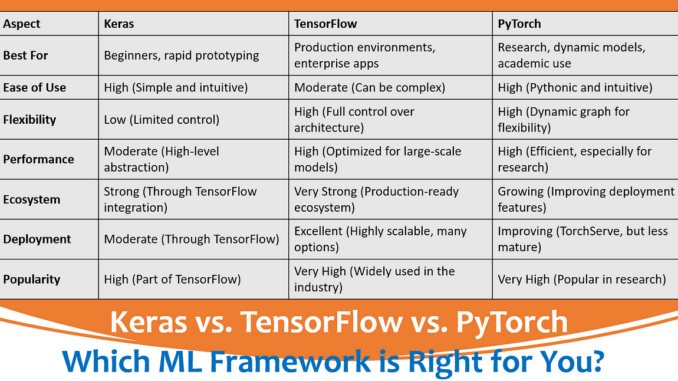
In the world of machine learning, choosing the right framework can make or break your project. With Keras, TensorFlow, and PyTorch leading the charge, each offers distinct advantages depending on what you’re trying to achieve. Whether you’re a beginner looking for simplicity, an enterprise aiming for scalability, or a researcher wanting maximum flexibility, there’s a framework tailored to your needs. Let’s break down the differences and explore which one might be best for you.
If you’re new to machine learning, Keras is probably the friendliest framework you can start with. It’s designed to be simple and easy to use, allowing you to build powerful deep learning models with just a few lines of code. Initially a standalone library, Keras is now the official high-level API of TensorFlow, which means you get the best of both worlds: the simplicity of Keras with the power of TensorFlow under the hood.
Why choose Keras?
- User-Friendly: Keras abstracts much of the complexity of building neural networks, making it a great tool for beginners and those who want to iterate quickly.
- Rapid Prototyping: Because Keras is simple, you can experiment with new ideas faster. It’s ideal for prototyping without getting bogged down by details.
- TensorFlow Integration: As Keras is now part of TensorFlow, it benefits from TensorFlow’s extensive ecosystem, offering scalability and deployment options.
Where Keras may fall short:
Keras trades off some control for simplicity. If you need highly customized architectures or very fine-grained control over every aspect of your model, you might find Keras a bit limiting. It’s great for getting started, but for complex projects, you might hit its boundaries.
TensorFlow, developed by Google, is one of the most widely used machine learning frameworks in the world. It’s powerful, flexible, and designed to work at scale, making it a favorite among enterprises. TensorFlow can handle everything from training models on your laptop to deploying them across a network of servers or even on mobile devices with TensorFlow Lite and TensorFlow Micro.
Why choose TensorFlow?
- Scalability: TensorFlow is designed for production environments. Whether you’re building a small prototype or deploying a large-scale model in the cloud, TensorFlow scales beautifully.
- Comprehensive Ecosystem: TensorFlow has a rich set of tools, from TensorFlow Extended (TFX) for end-to-end machine learning pipelines to TensorFlow Serving for deploying models at scale. It’s a one-stop-shop for AI solutions.
- Flexibility: Unlike Keras, TensorFlow offers more granular control over your model’s architecture, making it a good choice for developers who need that flexibility.
Challenges with TensorFlow:
The power of TensorFlow comes with a steeper learning curve. It’s more complex, and if you’re not familiar with machine learning or deep learning concepts, it can feel overwhelming at first. Also, for small-scale projects or quick iterations, TensorFlow might feel like overkill.
PyTorch, developed by Facebook’s AI Research lab, has exploded in popularity, particularly in the research community. Its dynamic computational graph, known as “define-by-run,” allows you to change the model structure on the fly, which is invaluable for experimenting with new ideas and architectures. PyTorch is also more “Pythonic” in nature, meaning it feels more intuitive for Python developers.
Why choose PyTorch?
- Dynamic Computational Graphs: PyTorch’s dynamic graphs allow for more flexibility in designing models. If you’re working on research or projects where the model architecture changes frequently, PyTorch makes it easy to experiment.
- Intuitive and Pythonic: PyTorch feels more like working with native Python, making it easier to learn and work with for developers who are already familiar with Python programming.
- Strong Research Focus: PyTorch is widely used in academic settings, so if you’re diving into cutting-edge AI research or working on experimental projects, PyTorch is often the go-to choice.
PyTorch’s downside:
While PyTorch has come a long way in terms of deployment tools, it historically lagged behind TensorFlow in production environments. However, this gap is closing with the introduction of TorchServe, a framework for deploying PyTorch models at scale.
- If you’re just starting out and want something simple and user-friendly, Keras is a great place to begin. It’s also ideal for rapid prototyping when you want to iterate quickly.
- If you’re working on a large-scale project or need to deploy your models in production, TensorFlow offers unmatched scalability and a comprehensive ecosystem.
- For researchers, academics, or anyone experimenting with new models, PyTorch provides the flexibility and dynamic graphing capabilities to let your creativity flow.
In the end, the choice depends on your specific project requirements. Each framework has its unique strengths, so understanding those will help you make the best decision. Whether you’re building an innovative AI solution for an enterprise or pushing the boundaries of machine learning research, there’s a framework that’s right for you.

Be the first to comment